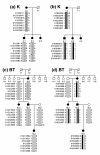CFEOM1, the classic familial form of congenital fibrosis of the extraocular muscles, is genetically heterogeneous but does not result from mutations in ARIX
- PMID: 11882252
- PMCID: PMC100320
- DOI: 10.1186/1471-2156-3-3
CFEOM1, the classic familial form of congenital fibrosis of the extraocular muscles, is genetically heterogeneous but does not result from mutations in ARIX
Abstract
Background: To learn about the molecular etiology of strabismus, we are studying the genetic basis of 'congenital fibrosis of the extraocular muscles' (CFEOM). These syndromes are characterized by congenital restrictive ophthalmoplegia affecting muscles in the oculomotor and trochlear nerve distribution. Individuals with the classic form of CFEOM are born with bilateral ptosis and infraducted globes. When all affected members of a family have classic CFEOM, we classify the family as a CFEOM1 pedigree. We have previously determined that a CFEOM1 gene maps to the FEOM1 locus on chromosome 12cen. We now identify additional pedigrees with CFEOM1 to determine if the disorder is genetically heterogeneous and, if so, if any affected members of CFEOM1 pedigrees or sporadic cases of classic CFEOM harbor mutations in ARIX, the CFEOM2 disease gene.
Results: Eleven new CFEOM1 pedigrees were identified. All demonstrated autosomal dominant inheritance, and nine were consistent with linkage to FEOM1. Two small CFEOM1 families were not linked to FEOM1, and both were consistent with linkage to FEOM3. We screened two CFEOM1 families consistent with linkage to FEOM2 and 5 sporadic individuals with classic CFEOM and did not detect ARIX mutations.
Conclusions: The phenotype of two small CFEOM1 families does not map to FEOM1, establishing genetic heterogeneity for this disorder. These two families may harbor mutations in the FEOM3 gene, as their phenotype is consistent with linkage to this locus. Thus far, we have not identified ARIX mutations in any affected members of CFEOM1 pedigrees or in any sporadic cases of classic CFEOM.
Figures


References
-
- Brown HW. Congenital structural muscle anomalies. In: JH Allen, editor. Strabismus Ophthalmic Symposium. St. Louis: C. V. Mosby Co.; 1950. pp. 205–236.
-
- Hotchkiss MG, Miller NR, Clark AW, Green WG. Bilateral Duane's retraction syndrome: A clinical-pathological case report. Arch Ophth. 1980;98:870–874. - PubMed
-
- Miller NR, Kiel SM, Green WR, Clark AW. Unilateral Duane's retraction syndrome (type 1). Arch Ophth. 1982;100:1468–1472. - PubMed
-
- Engle EC, Goumernov B, McKeown CA, Schatz M, Johns DR, Porter JD, Beggs AH. Oculomotor nerve and muscle abnormalities in congenital fibrosis of the extraocular muscles. Annals of Neurology. 1997;41:314–325. - PubMed
Publication types
MeSH terms
Substances
Grants and funding
LinkOut - more resources
Full Text Sources

